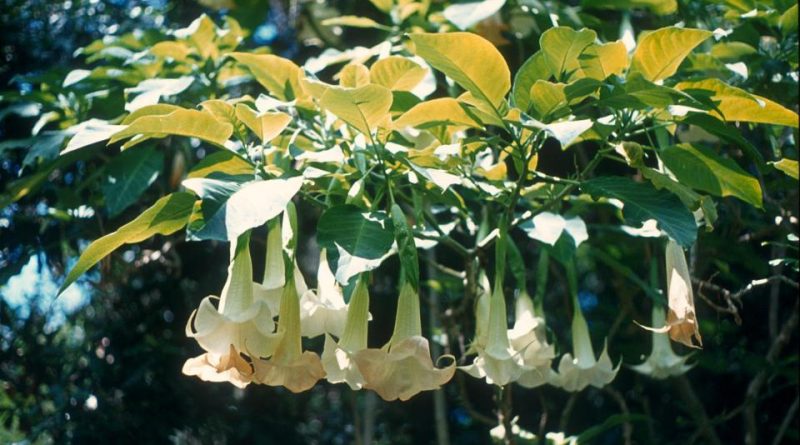Brugmansia arborea
Brugmansia arborea
The Stramonio arborea or Datura arborea (Brugmansia arborea (L.) Steud.) Is an arborescent species of the Solanaceae family.
Systematic –
From the systematic point of view it belongs to the Domain Eukaryota, Kingdom Plantae, Division Magnoliophyta, Class Magnoliopsida, Order Solanales, Family Solanaceae and then to the Genus Brugmansia and to the Species B. arborea.
Etymology –
The term Brugmansia was attributed in honor of the Dutch botanist and naturalist Sebald Justin (us) Brugmans (1763-1819). The epithet tree branch comes from árbor tree: that is, with an arboreal bearing.
Geographic Distribution and Habitat –
Tree Stramonium is a plant native to South-West America but is no longer present in its natural state. The plant is now grown in tropical or even temperate areas, provided that the areas are sheltered from freezing during the winter. In Italy it is cultivated mainly in the coastal areas of the south as an ornamental plant.
Description –
The arborescent stramonium is an arborescent plant characterized by an irregular brown-brownish stem that can reach and exceed even the 5 m of height; the color of the same takes on increasingly green shades of color as you approach the branches. It has very large and numerous leaves, sometimes hairy, with a decidedly ovate shape that in the apex assumes a more lanceolate outline. The flowers are pendulous, white but may also have shades tending to light yellow and orange, with dimensions ranging around 20-30 cm in length.
The fruit is a spongy berry containing numerous seeds.
Cultivation –
The Stramonio arborea or Datura arborea is a plant that can be grown in tropical or very mild areas also of the insular Mediterranean. In fact, he loves the mild climate, the positions in full sun or in the shade in places sheltered from the wind or close to walls. The plant adapts to any type of soil, even if it prefers calcareous, rich in organic substance and well drained. Plants grown in pots, in order to produce abundant flowering, require very large pots and soil mixed with clay and pumice. Even in the ground it should be watered periodically during periods of high heat and prolonged drought; the species grown in pot should be watered regularly and constantly every day, especially in summer and during the flowering period.
Pruning is carried out every year around the middle of May when the freezing period has been avoided. Generally the dry or damaged branches should be pruned completely while those too long and thin should be shortened. For details of the cultivation technique refer to the following sheet.
Uses and Traditions –
Brugmansia arborea is considered one of the most poisonous and toxic species in the world. The part that can also be deadly is the seed for the content in alkaloids such as hyoscyamine, atropine, scopolamine. Also the leaves of this species contain a high concentration of alkaloids including scopolamine.
This species is used by tribes and indigenous peoples as a poison for hunting. It is also used by the Yaqui sorcerers during some mystic rituals in order to approach the knowledge, because it has hallucinogenic effects. Brugmansia arborea is also used to extract scopolamine and for the preparation of pain-relieving tablets.
Datura assumes the meaning of mysterious, magical, incognito.
It is cultivated for ornamental purposes in mild climate areas.
Preparation Mode –
Due to its toxic characteristics it is strongly recommended not to use any part of the plant for improvised or amateur pharmaceutical purposes.
Guido Bissanti
Sources
– Acta Plantarum – Flora of the Italian Regions.
– Wikipedia, the free encyclopedia.
– Treben M., 2000. Health from the Pharmacy of the Lord, Advice and experience with medicinal herbs, Ennsthaler Publisher
– Pignatti S., 1982. Flora d’Italia, Edagricole, Bologna.
– Conti F., Abbate G., Alessandrini A., Blasi C. (edited by), 2005. An annotated checklist of the Italian vascular flora, Palombi Editore.
Warning: Pharmaceutical applications and alimurgical uses are indicated for informational purposes only and do not in any way represent a medical prescription; there is therefore no liability for their use for curative, aesthetic or food purposes.


